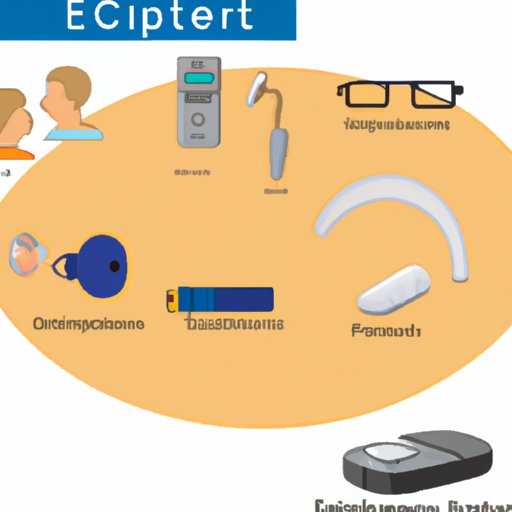Introduction
Hearing aids are small electronic devices that are worn by people with hearing loss to help them hear better. These devices are used to amplify sound and reduce background noise in order to improve their ability to communicate and interact socially. Hearing aids can also provide an added level of safety, as they can alert people to potential dangers such as cars or sirens that may be difficult to hear without the device.

Explaining the Different Components of Hearing Aids
Hearing aids are composed of several components, each of which plays an important role in how the device works. The most important components include a microphone, an amplifier, a receiver, and a battery. The microphone collects sound from the environment and converts it into electrical signals. The amplifier then increases the volume of those signals so that they can be heard more clearly. The receiver converts the amplified electrical signals back into sound waves, and the battery provides power to the device.
Describing How Hearing Aids Work and How They Help People Hear Better
Hearing aids use a variety of technologies to help people with hearing loss hear better. First, sound is converted into electrical signals by the microphone, which are then amplified by the amplifier. The amplified signals are sent to the receiver, which converts them back into sound waves. The sound waves are then delivered to the ear, allowing the person to hear more clearly. Additionally, many hearing aids also include noise reduction technologies that help reduce background noise and improve sound quality.
Examining the Different Types of Hearing Aids and their Functions
There are several different types of hearing aids available, each of which has its own unique features and functions. Behind-the-Ear (BTE) hearing aids are the most common type and fit behind the ear. In-the-Ear (ITE) hearing aids fit inside the outer ear and are typically larger than BTE hearing aids. In-the-Canal (ITC) and Completely-in-the-Canal (CIC) hearing aids are smaller than ITE hearing aids and fit partially or completely inside the ear canal.

Outlining the Benefits of Wearing a Hearing Aid
Wearing a hearing aid can provide numerous benefits for people with hearing loss. One of the most obvious benefits is improved communication, as hearing aids make it easier to understand conversations. Additionally, hearing aids can also help increase social interaction by allowing people to participate more easily in group conversations. Finally, hearing aids can provide an added layer of safety by alerting people to potential dangers that they may not otherwise hear.

Analyzing the Costs Involved with Purchasing a Hearing Aid
The cost of hearing aids can vary greatly depending on a number of factors, including the type of hearing aid and its features. In general, however, hearing aids can range from a few hundred dollars to several thousand dollars. Fortunately, many insurance companies offer coverage for hearing aids, and there are also numerous financial assistance programs available for people who need help affording them.
Highlighting Tips for Finding the Right Hearing Aid Provider
When looking for a hearing aid provider, it is important to do your research and ask questions to ensure that you find one who meets your needs. Start by researching providers in your area and reading reviews to get an idea of their reputation. When you meet with a provider, be sure to ask questions about their experience, services offered, and warranties. Understanding these details can help you make an informed decision when choosing a provider.
Conclusion
Hearing aids are important devices for people with hearing loss. This article has outlined how hearing aids work, the different types available, the costs involved, and tips for finding the right provider. By understanding how hearing aids work and taking the time to find the right provider, you can ensure that you get the best possible device for your needs.
(Note: Is this article not meeting your expectations? Do you have knowledge or insights to share? Unlock new opportunities and expand your reach by joining our authors team. Click Registration to join us and share your expertise with our readers.)
